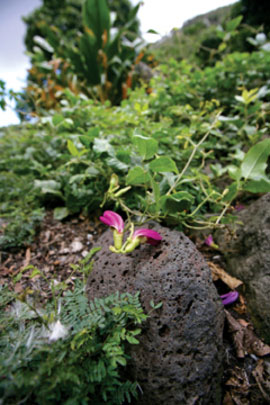Project Malama Honokowai gives us and other volunteers an opportunity to put our gratitude to work in a very real way. The project’s goal is to care for and preserve a valley that archaeologists describe as the region’s most prolific, intact example of a working village.
In 1999, Ka‘anapali 2020, a community-based planning project, contracted Xamenek Researches to conduct extensive surveys of Honokowai Valley. Those surveys revealed that beneath the dense foliage were numerous archaeological sites, including homes, farms, trails and heiau (places of worship)—evidence that the valley once contained a thriving, self-sufficient village of about 600 families.
But by the 1920s, a paradigm shift was occurring. The stream water the families used to irrigate their lo‘i was diverted for sugarcane cultivation. Their sustainability gone, the people left the valley to forge a new way of life—“from agriculture to the unknown,” Lindsey says.
A Native Hawaiian, Lindsey is president of Maui Cultural Lands, Inc. (MCL), a nonprofit land trust formed in 2002 to facilitate the restoration of cultural sites. As the most historically significant in the region, with the most prolific archaeological remains, Honokowai was number one on the list.
 Every Saturday morning for the last seven years, he and Puanani have been driving from their home Upcountry to the valley. Working with an ever-changing group of volunteers, they are clearing away the alien overgrowth from a steadily widening section of land, revealing rock walls, house sites and artifacts—the slow, piece-by-piece revelation of a buried treasure.
Every Saturday morning for the last seven years, he and Puanani have been driving from their home Upcountry to the valley. Working with an ever-changing group of volunteers, they are clearing away the alien overgrowth from a steadily widening section of land, revealing rock walls, house sites and artifacts—the slow, piece-by-piece revelation of a buried treasure.
“When we started, that was the only rock we could see,” Puanani says, pointing to a prominent boulder embedded in the stream bank.
Now, through the ongoing efforts of volunteers, you can clearly see the layout of the village—and feel the presence of its former inhabitants more strongly.
Technically, permission to do the work is granted by landowner Ka‘anapali Development Corporation (KDC). Still, Lindsey says, the real permission to do the work comes “from the spirit of the people who lived here.” “The work we are doing is to regenerate that spirit,” he says. “We are restoring the mana, the life force.”
Honokowai Valley might be the only place where you can accomplish that with a chainsaw. Volunteer Mitch Brinks, an ophthalmologist, has cut down hundreds of trees in Honokowai Valley over the last five years—invasives that compete with native species. “The only way I could’ve done that [safely] is with the spirits watching over me,” he says.
One of the many endangered native plants here is awikiwiki. Ancient Hawaiians woven this hearty vine into a loose basket for catching baitfish in tide pools.





